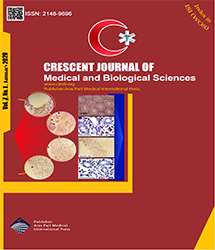| Original Article | |
| Epidemiological and Pathologic Characteristics of Gastric Polyps in Khorramabad City of West of Iran: A 10-year Experience | |
| Koroush Ghanadi1,2, Zahra Sadat Alavi3, Seyyed Amir Yasin Ahmadi4, Babak Khodadadi5, Khatereh Anbari6 | |
| 1Hepatitis Research Center, Lorestan University of Medical Sciences, Khorramabad, Iran 2Division of Gastroenterology, Department of Internal Medicine, Lorestan University of Medical Sciences, Khorramabad, Iran 3Student Research Committee, Lorestan University of Medical Sciences, Khorramabad, Iran 4Student Research Committee, Iran University of Medical Sciences, Tehran, Iran 5Young Researchers and Elite Club, Khorramabad Branch, Islamic Azad University, Khorramabad, Iran 6Social Determinants of Health Research Center, Lorestan University of Medical Sciences, Khorramabad, Iran |
|
|
CJMB 2020; 7: 29–33 Viewed : 4712 times Downloaded : 3536 times. Keywords : Polyps, Epidemiology, Endoscopy |
|
| Full Text(PDF) | Related Articles | |
| Abstract | |
Objectives: Gastric polyps are neoplastic lesions that are found in about 1% to 4% of patients who undergo gastroscopy. The present study aimed to have an epidemiological investigation on the endoscopic and pathological fndings of gastric polyp patients in Khorramabad in the west of Iran. Materials and Methods: This cross-sectional study was a 10-year experience in which seventy-two patients with gastric polyps were included from 2007 to 2016. Both descriptive and analytical statistics were performed and the chi-square or Fisher exact test was used for evaluating the intra-group associations at P=0.05. Results: Demographically, most subjects were females and middle-aged. The drug history of taking proton pump inhibitors (PPIs) and past medical history of gastritis were positive in many patients. The body of the stomach was the most common anatomical site and the polyps were usually single. Morphology and pathology wise, most polyps were superfcial and hyperplastic, respectively. A signifcant association was found between gender and anatomical site. Finally, most male patients had antral polyps whereas most female patients had body-sited polyps (P=0.044). Conclusions: In general, the site of the polyp was gender-related in this region. The history of gastritis and taking PPI was prevalent like the other studies. Some gastric polyps are more at the risk of malignancy thus such polyps should be followed up in the patients. |
Cite By, Google Scholar
Google Scholar
PubMed
Online Submission System
 CJMB ENDNOTE ® Style
CJMB ENDNOTE ® Style
 Tutorials
Tutorials
 Publication Charge
Medical and Biological Research Center
About Journal
Publication Charge
Medical and Biological Research Center
About Journal
Aras Part Medical International Press Editor-in-Chief
Arash Khaki
Deputy Editor
Zafer Akan


















